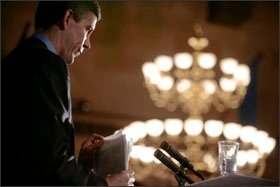Includes updates and/or revisions.
A new report card on state-level innovation in education by a trio of ideologically varied groups reports what they see as deeply disturbing results, with most states earning C’s, D’s, or even F’s in such key areas as technology, high school quality, and removal of ineffective teachers.
The report, “Leaders and Laggards,” uses state data and existing and original research to assign letter grades to states, based on seven indicators of innovation: school management, finance, hiring and evaluation of teachers, removal of ineffective teachers, data, “pipeline to postsecondary” (or high school quality), and technology.
Though the report released last week does not give states overall grades, the worst marks are in the category of removing ineffective teachers. But most states got C’s and D’s in the other categories.
“We found only a faint pulse of innovation,” said Thomas J. Donohue, the president and chief executive officer of the U.S. Chamber of Commerce, which co-sponsored the report and hosted a Nov. 9 event here surrounding the report’s release. “We must turn that into a strong heartbeat.”
Varied Interests
The report card is notable for its sponsorship by not only the Chamber of Commerce, which represents business interests, and the American Enterprise Institute, a free-market-oriented think tank, but also the Democratic-leaning Center for American Progress. All three groups are based in Washington.
Among the sources for the report were data from the National Center for Education Statistics’ Schools and Staffing Survey, the Thomas B. Fordham Institute, and the Editorial Projects in Education Research Center.

All the sponsors agreed that the results were “deeply disturbing,” in the words of John Podesta, the president and CEO of the Center for American Progress, who served as White House chief of staff under President Bill Clinton.
But there were bright spots.
Massachusetts, Colorado, and Rhode Island got gold stars for their policies to promote extended learning time in schools, while Arizona, Ohio, and Florida got that designation for their aggressive charter school accountability approaches. Hawaii was singled out as the only state with a school-based funding policy. All are signals of innovation, according to the report.
Still, the 1.4 million-member American Federation of Teachers labeled the report as full of “old-hat, top-down measures that have failed to transform our schools,” according to a statement.
“The report’s recommendations are little more than a defense of the factory model of education, which has of late turned schools from havens for learning into test-taking factories,” AFT President Randi Weingarten said in the statement.
Multiple Factors
The report card incorporates many factors into a state’s overall letter grade for each of the seven indicators.
To weigh innovation in teacher hiring and evaluation, for example, the researchers measured a state’s percentage of alternatively certified teachers (the higher the better), whether the state uses national programs (such as Teach For America) to recruit educators, and other factors.
What researchers were not doing was measuring “nifty, faddish experiments,” said Frederick M. Hess, the director of education policy studies at the American Enterprise Institute. Instead, the analysis was meant to examine whether a state has created a “flexible, performance-oriented culture,” he said.
The report’s focus on innovation fits with the education agenda of the Obama administration, which last week released final rules for the Race to the Top Fund competition. The fund will award $4 billion in grants to states. (“Starting Gun Sounds for ‘Race to the Top,’ ” this issue.)
U.S. Secretary of Education Arne Duncan, who gave opening remarks at the Nov. 9 event, said the quality of the country’s education system is as important an indicator of economic health as the “stock market, the unemployment rate, or the size of the GDP.”
The Chamber of Commerce, which is a powerful lobbying force at the federal, state, and local levels, has been at sharp odds with the Obama administration over health care and climate change.
But not on education.
“The administration is setting the right tone and putting its money where its mouth is,” Mr. Donohue said, specifically praising the Race to the Top initiative.
Secretary Duncan acknowledged the tension between the administration and the chamber, but said: “Education is the most bipartisan issue.”
The guiding principles behind Race to the Top—the so-called “four assurances” attached to the American Recovery and Reinvestment Act, which includes money for the grants program among some $100 billion in education aid—appear to be here to stay. In exchange for receiving federal stimulus money, states have to agree to improve teacher effectiveness, data systems, academic standards, and their lowest-performing schools, according to the law.
Mr. Duncan used his remarks to emphasize that the administration wants to “embed” the four assurances into broader federal law, specifically the Elementary and Secondary Education Act, of which the No Child Left Behind Act is the current version.
He also highlighted his four other priorities for ESEA reauthorization, which is expected to get going next year: setting a high bar for states and districts, but allowing them to innovate; building in more competition for federal dollars; reviewing federal education spending line by line and focusing federal education aid on the programs that are most effective; and moving accountability from a “one-size-fits-all” approach to something more flexible.





